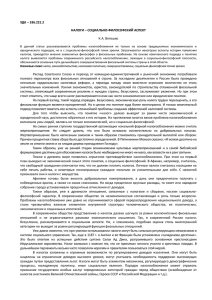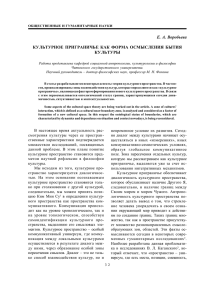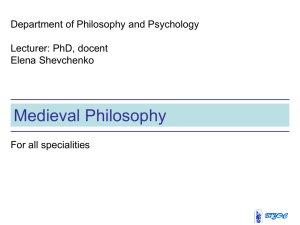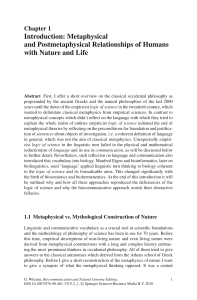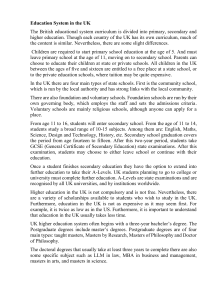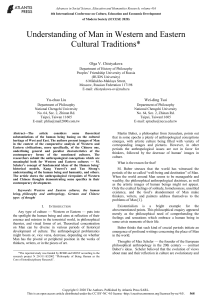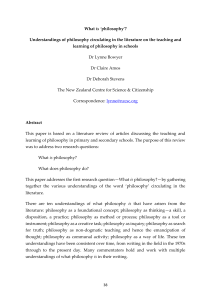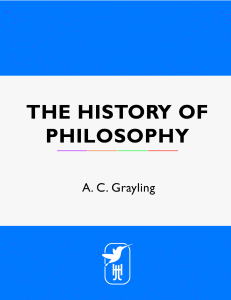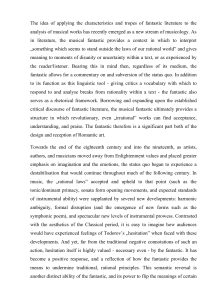КОМПОЗИТОРСКАЯ ТЕХНИКА И НЕВЫРАЗИМОЕ: К
реклама
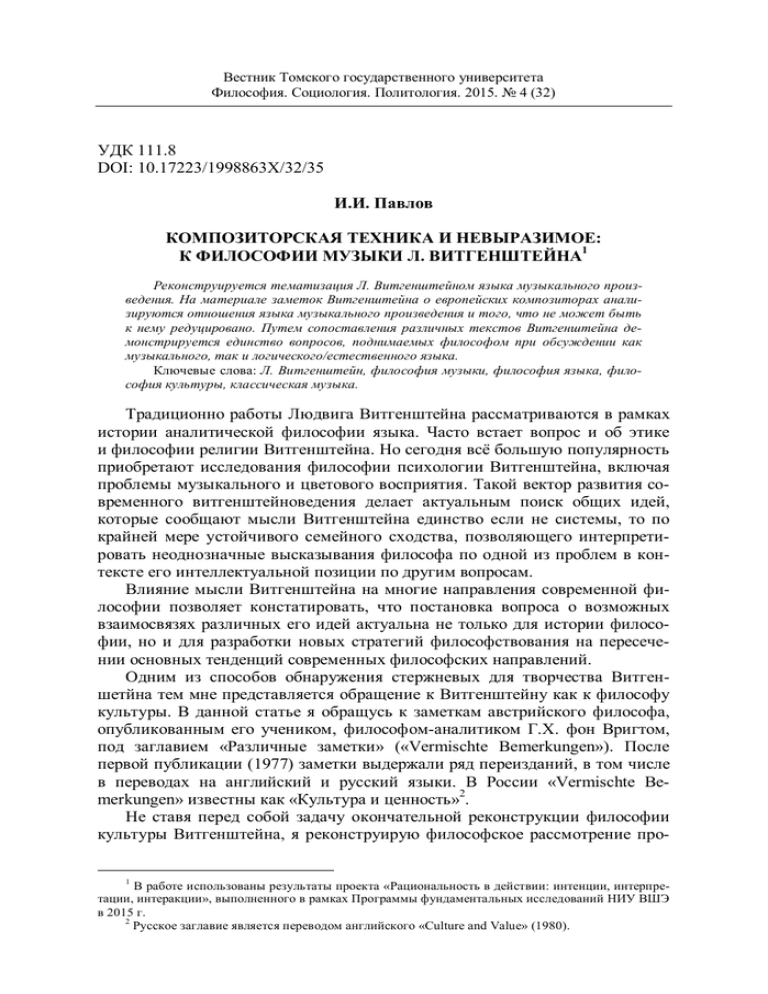
. . . 2015. 4 (32) 111.8 DOI: 10.17223/1998863 /32/35 . : 1 . . - . , . , , . : . , , , , - . . . , . , , , . - , - , . . , « (1977) merkungen» « , . , » («Vermischte Bemerkungen»). , . «Vermischte Be»2. , 1 , 2015 . 2 - « : », «Culture and Value» (1980). , - : . 327 , « - », . : , , », , « , . « » , . , , , , , , , . , , - , . . - , .« , » , , [1. . 78–79]. , - , : –« - », [1. . 71]. ( , , ) , – , , . – 1 : . , , [1. . 120]. « », « ». ( ): , [1. .90–91]. 1 , ; , , , . , , « »( », , , , ) [1. . 107]. , – , [1. . 33]. , - , , - , [1. . 79]. , « , » . 328 – XIX . « , , », XIX « , » [1. XX ., , . , - . 25]. : , . [1. . 33–34]. – » - – [1. . 87, 119]. , . (1824–1896), , , [1. . 102] – XIX . , , » . [1. . 39]. « - , , [1. . 33]. [1. . 26]. , XIX . , ,– . :« . . » [1. . 52]. , » [1. . 119]. - : . 42], [1. [1. - » [1. . 49], « . 46]. , :« , - , . » [1. . 43]. , [1. » » [1. . 122], « » , , . 25–26] ( « ). , . . XIX . – , - , – , – («… , 1 , , , ,– ,– 1 . , , . - . » [1. . 24]. - : ») [1. . 25]. »1, . 329 , « « » [1. . 64], », [1. . 67]. - , , [1. . 45]2. [1. . 49]. , « ». , , - , « »3. » « – [1. . 55–56], – , ) ( . 5 . [1. . 110]4, [1. . 83], [1. . 105]. - , « – - »: - , [1. . 218–219; , §527]. [1. . 66]. [1. . 35]. – - ? , , §66], [ , , , , . , « »– », – , , 393], , § 380– . [ . :« » [1. . 107]6. , , - , , [3. . 232]. 1 –« 2 » [1. . 40]. – , , , 3 , « 4.0141 « - « », ». 4.014 - », , , . 4 , – 5 6 , [1. . 49, 73]. , .: «… , « « » » [3. . 218]. , »[ , §23]. . 330 , , , - [1. . 42]. , , , . 64], [1. . ( , ), , , [1. . 46]. , . - , . , [1. . 64], , , , , 1 . ( ) . 65] – , « » [1. , ». , ? « - » , »( ), « », - .« , , <…> » [1. . 33]. , - , ,– , ,– 2 « », . , , ( ) , « , » [1. »: « . 110]. <…> , ( , - ) [1. . 53]. , « ,— , » . - « « », », 1 » [1. , . 111]. - –« <…> « - » [1. . 120]. 2 « »[ , " "» [ , 5.641]. , 5.6]; « , « « », . , , . » - : . 1 [1. . 29] . , « , , – « , . 67]. , », » [1. « » [1. . 25]. , 331 , - [1. . 24]. ? « –« » [1. . 25]. , – », , , - – , [1. . 31]. « – ,– , , », . 42] – [1. . « - », [ »[ »[ , 6.4] , 6.42]: « , « , 6.42]. , - . , « » , . , , , , . , , , , - , . . , « - », , , . , , . , . , . 1. : . , 2010. . 15–126. // 1 , . . , [1. . 39]. .: - . 332 2. 2011. 3. , 2008. 4. , 2011. . . »/ . . . . . . / .: + : , . . . . . . « », : . « . . .: : Pavlov Ilya I. National Research University Higher School of Economics (Moscow, Russian Federation) DOI: 10.17223/1998863 /32/35 COMPOSITIONAL TECHNIQUES AND INEXPRESSIBLE: TO L. WITTGENSTEIN’S PHILOSOPHY OF MUSIC Keywords: L. Wittgenstein, philosophy of music, philosophy of language, philosophy of culture, classical music. Ilya Pavlov’s article searches the aspects of L. Wittgenstein’s philosophical heritage, which can help researcher to find the new fruitful strategies for interpretation Wittgenstein’s philosophy in general. Author emphasized that Wittgenstein’s reflections on the music are one of these aspects because they helps to see how philosopher’s ethical, cultural and religious concepts correlates with published works on analytical philosophy of language. For this research author uses L. Wittgenstein’s notes “Culture and Value”. In this source author analyzes philosopher’s point of view on the great European composers as well as his reflections on the compositional technique, the musical form and the music. Then the paper deals with more general Wittgenstein’s thoughts about the religion, culture, nations and the historical path of the Europe, which can be found in notes “Culture and Value”. Author considers these general metaphysical ideas to be linked with the analogical places in Wittgenstein’s notes and his published works “Logical-Philosophical Treatise” and “Philosophical Investigations”, which demonstrate the correlation between the functions of the musical language and the natural language of people’s everyday communication. Wittgenstein’s judgments about the composers are analyzed not in order of appearance in the text of notes “Culture and Value”, but in chronological order. So, chaotic notes of philosopher are grouped together in systematic review of European culture’s history. Basing on the quotes from Wittgenstein’s notes, author demonstrates the analogies in wittgensteinian description of polyphonic language of baroque music and solemn one of romantic music of XIX century. Both, they are some compositional techniques which can express the musical composition’s spirit irreducible to this technique (Bach, Beethoven) as well as only develop empty musical form (Mendelssohn, Shubert). This irreducible spirit can’t be analyzed. It designates that language of the music as well as the natural language in its everyday practice are based on people immediate life and the characters of the persons. Analysis of music, language and its understanding by human faces many philosophical problems because the human life can’t be reduced to formal schemes and techniques. At the same time, these techniques (such as counterpoint) can’t be abstracted from existential and metaphysical aspect of the life. References 1. Wittgenstein, L. (2010) Kul'tura i tsennost'. O dostovernosti [Culture and values. About reliability]. Transalted from German. Moscow: AST: Astrel'. pp. 15–126. 2. Wittgenstein, L. (2011) Logiko-filosofskiy traktat [Tractatus Logico-Philosophicus]. Translated from German. Moscow: Kanon+ ROOI Reabilitatsiya. 3. Wittgenstein, L. (2008) Golubaya i korichnevaya knigi: predvaritel'nye materialy k “Filosofskim issledovaniyam” [The blue and brown books: preliminary materials for the “Philosophical Investigations”]. Translated from English by V.A. Surovtsev, V.V. Itkin. Novosibirsk: Siberian University Publ. 4. Wittgenstein, L. (2011) Filosofskie issledovaniya [Philosophical Investigations]. Translated from German by L. Dobrosel'skiy. Moscow: AST: Astrel'.

